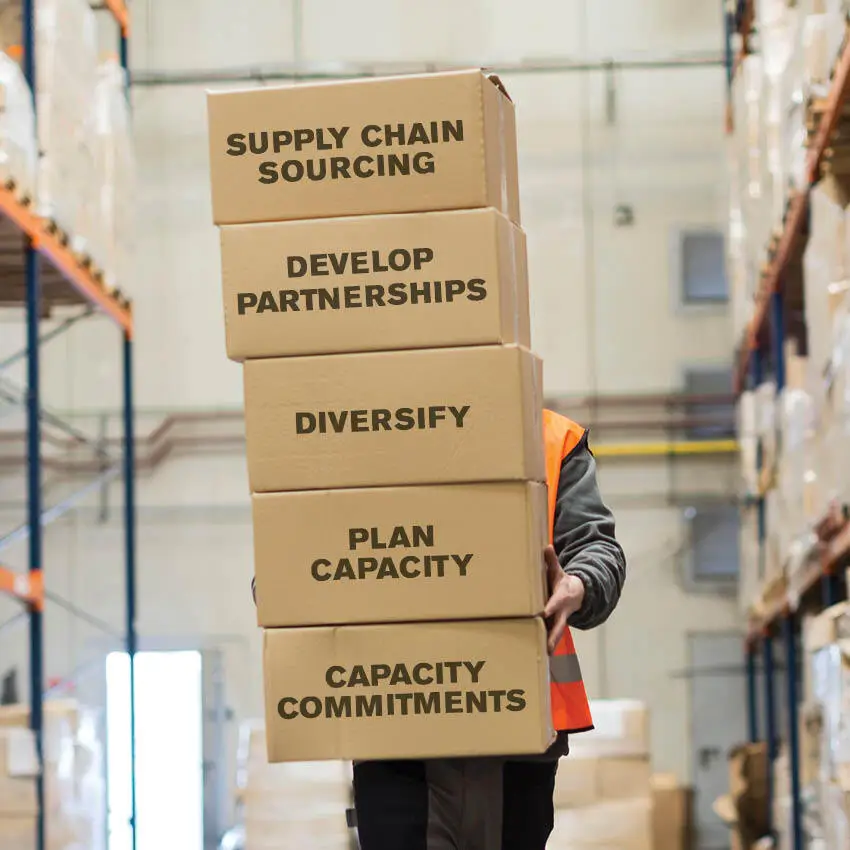Retailers and consumers alike have made supply chain a household conversation. With favorite brands missing from the shelves and out of stock messages showering the websites, all of us went into a pre-holiday spiral. News of offshore containers, late seasonal merchandise and delayed delivery notices put logistics front and center, shifting the way that most people and industry professionals previously took it for granted. Fast forward to the new year and retailers are prioritizing their investments to revisit their own supply chains to have more transparency and build more resilience against negative external conditions.
Sourcing strategy and procurement practices cannot give you immunity to supply chain volatility. Implementing a sourcing strategy that leverages partnerships and diversity and developing capacity planning and commitment capabilities for finished goods and materials can greatly increase the resilience of your supply chain.
Playbook for 2022
So, where should retailers start? The Columbus Consulting LIST (Logistics, Inventory, Structure and Technology) is designed as a strategy to accelerate omni-success. We recommend using the LIST matrix and going back to some basics. Here are five key questions with suggestions to reevaluate your supply chain issues.
- Supply Chain Resilience Begins at the Source: Is your sourcing and procurement strategy helping or hindering your ability to manage and mitigate risk within the supply chain?
We all hoped that 2022 would see less turmoil in the supply chain. Early signs seem to indicate otherwise. Manufacturing and logistics will continue to face obstacles and be areas of concern for supply chain and operations leaders. These obstacles are unavoidable and are impacting everyone in the consumer goods space. Your sourcing and procurement practices may be amplifying these negative impacts to your business. On the flip side, the right sourcing and procurement strategies can be a competitive advantage and provide an increased resilience factor to across the supply chain. - Develop Partnerships: Have you developed strong partnerships with the factories that make your products?
If not, start developing those relationships now. Think about which vendors (finished goods manufacturers as well as material suppliers) manufacture your most important and/or critical products. Develop strategic partnerships with these vendors that focus on mutual benefit across all aspects of the relationship. Partnerships create trust and commitment in the relationship which will enable richer collaboration on problem solving during times of disruption and will allow for shared roadmaps for long term growth. - Diversify: Do you have the appropriate levels of diversity in your source base to help mitigate risk and provide resilience?
Having all your production and materials sourced in one country of origin or having a single factory partner puts you at significant risk. Start with your most important or critical products. Does my current supplier have manufacturing in more than one country of origin? While it may cost a little bit more, consider commercializing the same products at both manufacturing locations. Do the same with critical materials when possible. As your volumes scale you should also look to multisource key products across two or more manufacturing partners and material vendors. As you diversify your source base, look at on-shore and near-shore options as well as the traditional off-shore locations. Moving your manufacturing base closer to the marketplace will shorten lead time, improve responsiveness, and reduce logistics obstacles. A diversified supplier base gives you increased flexibility to deal with supply and logistics issues that may arise. - Plan Capacity: Do you have a plan to evolve your capacity planning beyond rough-cut capacity?
Hopefully you are already doing rough-cut capacity planning. That effort gets you in the ballpark for manufacturing and materials capacity. Developing a more robust capacity plan will provide you with greater visibility and control over the flow of your supply, the lead times within materials and finished goods manufacturing, and procurement decisions. At a minimum your capacity plan should be at month level granularity and include key capacity types as well as any known bottlenecks in the manufacturing process. This level of capacity planning should cover a six- to nine-month rolling horizon leading up to the procurement lead time.
In the absence of a month level capacity utilization plan, you run the risk of seeing your lead times increase. You are also at risk of having too much or not enough capacity at critical moments in your supply cycle. By developing more detailed capacity utilization plans you can right size your available manufacturing resources and take ownership of production smoothing versus supply needs. Making advanced purchases (prebuilding) on a product with strong year-round demand to keep open capacity closer to the selling season for seasonal products provides better marketplace responsiveness. The capacity utilization plan also enables you to make informed decisions for when and at what quantities to activate your dual sourced product strategy.
- Capacity and Material Commits: Do you keep the focus on your most important products in evolving your sourcing strategy and procurement practices?
Retailers need to begin making capacity commitments with the express objective to reduce purchase order lead times. The longer the lead times the less resilience. When you commit to a specific volume of raw materials instead of cutting a purchased order for a specific product, you maintain flexibility in where those materials go and how they are utilized. If the factory in China is dealing with a production backlog due to government enforced rolling power outages, you can shift those materials to the factory in Vietnam that is ahead of schedule or sitting at only 80 percent utilization. Capacity and resource commitments also give forward visibility and an increased confidence level on the resources available. This allows proactive decision making to minimize risk and enables quick decision making for greater resilience when disruptions occur within your supply chain.
Start Now!
Wherever your organization is on your supply chain journey, it’s important to continue to evolve. Like any other strategic initiative within an organization, there is really no start or finish. As you move into and through 2022, ask yourself the above questions and engage your teams in honest conversations about how to manage the issues.
Sourcing strategy and procurement practices cannot give you immunity to supply chain volatility. Implementing a sourcing strategy that leverages partnerships and diversity and developing capacity planning and commitment capabilities for finished goods and materials can greatly increase the resilience of your supply chain.
Note: Columbus Consulting is a Robin Report Collaborative Partner




